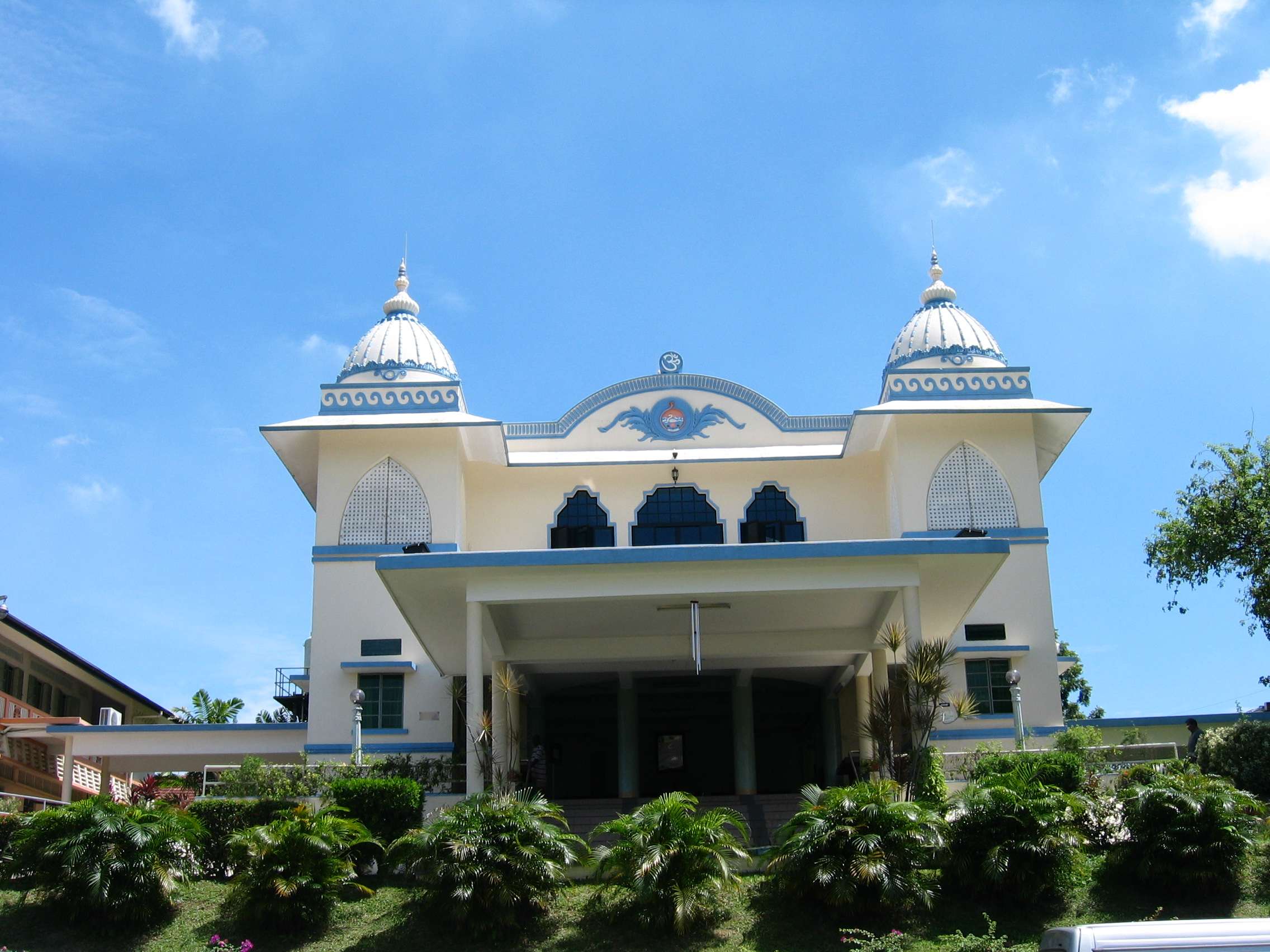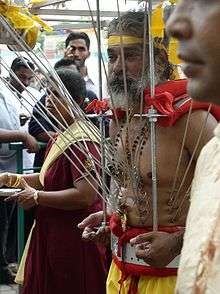Hinduism in Singapore

Hindu religion and culture in Singapore can be traced back to the 7th century AD, when Temasek was a trading post of Hindu-Buddhist Srivijaya empire.[1] A millennium later, a wave of immigrants from southern India were brought to Singapore, mostly as coolies and indentured labourers by the British East India Company and colonial British Empire.[2][3] As with Malay peninsula, the British administration sought to stabilise a reliable labour force in its regional plantation and trading activities; it encouraged Hindus to bring family through the kangani system of migration, settle, build temples and segregated it into a community that later became Little India.[4][5]
There are currently about thirty main Hindu temples in Singapore, dedicated to various gods and goddesses. There were an estimated 260,000 Hindus in Singapore in 2010.[6] Hindus are a minority, constituting about 5.1% of adult Singapore citizens and permanent residents in 2010. Almost all Hindus in Singapore are ethnic Indians (99%), with some who have married into Hindu families. Hinduism peaked at 5.5% of the total population in 1931.[7]
In Singapore, the Hindu festival of Deepavali is recognised as a national public holiday. Some non-Indians, usually Buddhist Chinese, participate in various Hindu activities. Unlike various states of Malaysia and Indonesia, Singapore places no restrictions on religious freedoms of Hindus.
| Year | Percent | Increase |
|---|---|---|
| 1849 | 2.8% | - |
| 1911 | 5.0% | +2.2% |
| 1921 | 4.6% | -0.4% |
| 1931 | 5.5% | +0.9% |
| 1980 | 3.6% | -1.9% |
| 1990 | 3.7% | +0.1% |
| 2000 | 4.0% | +0.3% |
| 2010 | 5.1% | +1.1% |
| 2015 | 5.0% | -0.1% |
Population of resident ethnic group registered as Hindus 2015.[8]
| Ethnic Group | Population of Resident Ethnic Group registered as Hindus | Percentage Resident Ethnic Group registered as Hindus | Percentage of Resident Population | Total Resident Population of Ethnic Group |
|---|---|---|---|---|
| Chinese | 300 | 0.012% | 76.84% | 2,517,580 |
| Malays | 100 | 0.03% | 11.88% | 389,090 |
| Indians | 161,800 | 59.88% | 8.25% | 270,220 |
| Others | 400 | 0.403% | 3.03% | 99,300 |
| Overall | 162,600 | 4.964% | 100% | 3,276,190 |
Beginnings of Hinduism in Singapore
Hindu religion and culture in Singapore can be traced back to the 7th century Hindu Srivijaya empire when Temasek was a small trading post.[1] By the 10th century, Tamil Chola influence arrived. With Islam's expansion in the region from 14th through 17th century, the Hindu-Buddhist influence, in and around Singapore, faded. The colonial era brought major changes in the seats of power and religious influence in the region.[4]
The early 19th century saw a wave of Hindu immigrants to Singapore from southern India, mostly Tamils, brought in to work as coolies and labourers by the British East India Company in Singapore.[4][5] These immigrants brought along their religion and culture. Their arrival saw the building of temples throughout the island in the Dravidian form of architecture, and the beginnings of a vibrant Hindu culture.
Though the labourers were mostly responsible for introducing and preserving their religion in their new home, in later times, monetary contributions were made by the richer Hindu merchants to build up the makeshift shacks that served as their place of worship. The temples also served to hold the community together, being a source of comfort to those far away in a foreign land.
The first Hindu temple
The first temple, Sri Mariamman Temple in Chinatown, was built as early as 1827 by Narayana Pillai, a clerk to Sir Stamford Raffles; it was dedicated to the Hindu goddess Mariamman, an incarnation of the Mother Goddess, and who is believed to have the power to cure diseases. He first erected a wooden, thatched hut on this site that he had purchased in 1823. The present temple was completed by 1863.
Architecture
The Hindu temples of Singapore are built in the Dravidian style, mainly the Tamil style found in Tamil Nadu, India. This style is known for its imposing 'gopurams' or entrance towers, complex friezes, intricate carvings and paintings or murals done on the walls and ceilings.
Today
There are currently about thirty main temples in Singapore, dedicated to various gods and goddesses from the Hindu pantheon. Today, two government bodies deal with all Hindu affairs — The Hindu Endowments Board and The Hindu Advisory Board.
Hindus make up a minority, comprising about 5.1%(2010 Census) of adult Singapore citizens and permanent residents. Among 15 years or older population, there were about 158,000 Hindus according to Singapore's 2010 Census; 37% of all Hindus in Singapore speak Tamil at home, while another 42% speak English.[9] Vast majority of Hindus in Singapore are ethnic South Indians. The small numbers of non-Indian Hindus are mainly Chinese women who were adopted by or married into Hindu families.

Singapore celebrates Hindu festival of Deepavali as a national public holiday, alongside the religious holidays of other communities. Two Hindu temples have been gazetted as National Monuments of Singapore. These are the Sri Mariamman Temple and the Sri Srinivasa Perumal Temple. Like many Hindu temples in Singapore, these were built in the South Indian Dravidian style and serve a broad South Indian Tamil community.
Different communities have also established their own temples in Singapore. For instance, the Sri Lankan Tamil community established the Sri Senpaga Vinayagar Temple at Ceylon Road and the Chettiar community set up the Sri Thandayuthapani Temple at Tank Road. The North Indian community also established the Sri Lakshminarayan Temple, built in the North Indian style.
In Singapore a number of non-Indians, such as Buddhist Chinese, participate in a variety of Hindu activities, including praying to Hindu deities, donating money to the temple funds and participating in Hindu festivals like Deepavali, the fire-walking ceremony, and Thaipusam. Certain temples, such as the Sri Krishnan Temple in Waterloo Street, or some Hindu temples in Yishun have also built up substantial followers among the Chinese community, who often visit these temples on their way to or from visiting nearby Chinese temples.
Holiday
In Singapore,only Deepavali is an Official Hindu holiday.Thaipusam is not a holiday.For Christians and Muslims two holidays each were given,while for Hindus only one public holiday was given under the Singapore's 1966 Holidays Act.[10]After this ,there has been a call from Hindus to reinstate Thaipusam as a public holiday.In 2015,a petition was launched by educator Sangeetha Thanapal which attracted nearly 20,000 signatures.A rally was also planned in Hong Lim Park but was Cancelled by the Police.[11][12]
Hindu religious festivals


Some of the major Hindu festivals celebrated every year include Deepavali (Divali), Thaipusam, Pongal, Tamil New Year or Varsha Pirappu, Holi also known as Festival of Colours and Thimithi or otherwise known as the Fire Walking Festival.
- Deepavali/Divali - For about one month before the festival, the Little India heritage district is decorated. Its public streets are festooned with colourful ornamental lights, often depicting Indian motifs, such as elephants, peacocks and oil lamps. At least two different Deepavali bazaars are held in different parts of the district, one at Little India Arcade, and another in an open field opposite Mustafa Centre. These markets are busy in the days leading up to the festival, and they contain small stalls selling Deepavali greeting cards, traditional foods and drinks, Indian-themed decorations for the home, traditional Indian costumes as well as more modern clothes, Indian music and video discs, sparklers and toys for children, oil lamps, incense, deities and other paraphenilia for family altars, etc. The districts becomes especially lively and colourful during this period, and many people, including non-Hindus residents and tourists will visit the area to enjoy the atmosphere.
- Thaipusam - As part of a penance to Lord Murugan, participants carry 'kavadis' along a processional route. Some of the adult male participants carry kavadis that are attached to their bodies via metal hooks and small spears that pierce their skin. This annual festival is the only time in contemporary Singapore when major roads in the city, including the parts of the prime Orchard Road area, are closed for a religious procession. The procession starts at the Sri Srinivasa Permal Temple in Serangoon Road, and winds through Orchard Road and Penang Road before ending at the Sri Thandayuthapani Temple at Tank Road, off Clemenceau Avenue. The festival is a major religious and urban event, which draws large numbers of participants, devotees, supportive family and friends as well as curious onlookers, photography enthusiasts and tourists.
- Panguni Uthiram - Like Thaipusam, this festival is in celebration of Lord Murugan. However, this is in celebration of Lord Murugan's Birthday.Hundreds of people flock the Holy Tree Balasubramaniam Temple in Yishun and the Sri Murugan Hill Temple in Upper Bukit Timah Road.People also carry kavadis and milk pots in honour of Lord Murugan. However the route is much shorter than in Thaipusam om one end of Yishun Industrial Park A to the other end.In Singapore,2008's Panguni Uthiram is on March 21 the same day as Good Friday
See also
References
- 1 2 Marshall Cavendish, The World and Its Peoples: Malaysia, Philippines, Singapore, and Brunei, ISBN 978-0761476429, pp. 1287-1288.
- ↑ Ato Quayson et al. (2013), A Companion to Diaspora and Transnationalism, ISBN 978-1405188265, Wiley-Blackwell, pp. 405-406
- ↑ Edwin Lee (2008), Singapore: The Unexpected Nation, Institute of Southeast Asian Studies, ISBN 978-9812307965, pp. 34-35.
- 1 2 3 Edwin Lee (2008), Singapore: The Unexpected Nation, Institute of Southeast Asian Studies, ISBN 978-9812307965.
- 1 2 Jean Abshire (2011), The History of Singapore, ISBN 978-0313377426, pp. 66-78.
- ↑ Table: Religious Composition by Country, in Numbers Pew Research Center (2012)
- ↑ Lai Ah Eng, Religious Diversity in Singapore, Institute of Southeast Asian Studies, 2008.
- ↑ "Religion by Ethnic in Singapore 2015"
- ↑ Census of population 2010 Archived 2013-11-13 at the Wayback Machine. Singapore Department of Statistics (2011)
- ↑ https://sso.agc.gov.sg/Bills-Supp/54-1966/Published/19661207?DocDate=19661207
- ↑ http://www.asiaone.com/singapore/mom-bid-make-festival-public-holiday-will-stir-competing-claims
- ↑ https://sg.news.yahoo.com/why-thaipusam-is-no-longer-a-public-holiday-in-singapore-050043065.html
External links
- Hindu Endowments Board - Governmental Organisation

